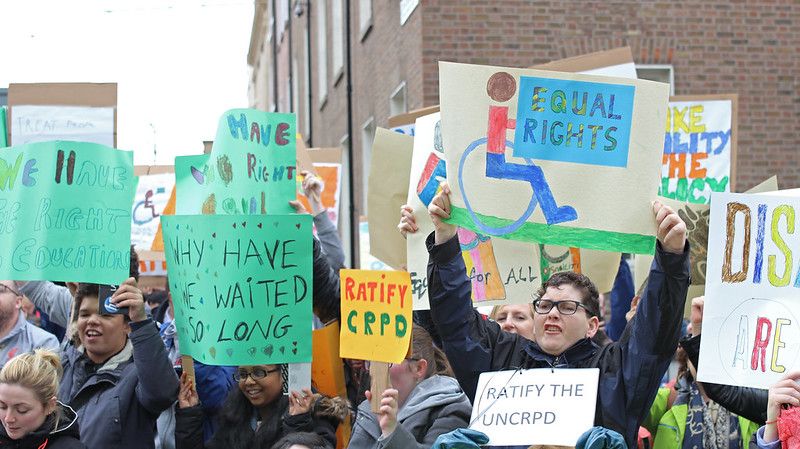Foto: Inger Kristin Hognestad
Activity:
Task: Make rules for an inclusive society!
Photo: Inger Kristin Hognestad
Quick facts

Disability rights • Human rights

Youth school • High school • Adult education • Organizations and others

Ca 2 hours

Materials: Large sheets of paper for writing down the rules. It must also be possible to submit answers digitally or orally.
Activity goals
- Increase knowledge about the UN Convention on the Rights of Persons With Disabilities (CRPD).
- Raise awareness about the basic principles of the CRPD.

In 2024, HRA has published new teaching materials on the rights of people with disability, minority stress and civil society. The project was supported by Lennox Foundation.
Instructions
Clarification of concepts (10 minutes):
- Article 1 of the Convention on the Rights of Persons with Disabilities defines persons with disabilities as: Persons with disabilities include those who have long-term physical, mental, intellectual or sensory impairments which in interaction with various barriers may hinder their full and effective participation in society on an equal basis with others.
- Disability is a broad concept that encompasses very different types of disability and may include anything from an allergy and chronic illness to reading and writing challenges, impaired sight or hearing, reduced mobility, developmental disability or mental illness (Norwegian Directorate for Children, Youth and Family Affairs).
Tips: Carry out the group work “Disability and identity” as preparation.
Group work part 1 (35 minutes):
- The facilitator divides the participants into groups and gives the following task: Your group has been given an important task. You must make ten rules for your neighbourhood (school, rural district or town) which will as much as possible enable people with disability to take part in society along the same lines as others. The rules can be presented digitally, verbally or in writing.
- All the groups present their proposed rules (rights) and explain why they have chosen them.
Presentation
- The facilitator gives a brief introduction to the UN Convention on the Rights of Persons with Disabilities:
- “All human beings are born free and equal in dignity and rights." Thus starts Article 1 of the Universal Declaration of Human Rights adopted by the United Nations in 1948. This document declared that all human beings have fundamental rights and that the states must secure these rights. But there was a challenge: the Universal Declaration was not legally binding. This meant that even if the states said that they were in agreement with the Declaration, they did not promise to follow up and comply with it.
- In the following years the UN worked on adopting legal agreements – Human Rights Conventions – the states were obliged to comply with once they had ratified them. When ratifying a convention the authorities must amend their legislation and practices that are in violation of the agreement.
- Even though all people are included in the human rights conventions, it was clear that some groups needed stronger protection of their rights. Examples include women, children and people with disability.
- The UN started work on developing a separate convention for people with disability in 2001. A committee composed of representatives from various countries was convened to discuss and draft an outline of a convention (like your group did in the group-work session). The Convention on the Rights of Persons with Disabilities was adopted in 2006, conferring on people with disability the “full and equal enjoyment of all human rights and fundamental freedoms” (Article 1).
Group work part 2 (20-30 minutes)
- The facilitator hands out an easy to read version of the UN Convention on the Rights of Persons with Disabilities. Here you can find different versions of the Convention on the Rights of Persons with Disabilities (link). The same groups that made their own ten rules (in Part 1) are now given the task of linking their ten rules to the eight general principles (basic rules) that the UN Convention on the Rights of Persons with Disabilities builds on (Article 3):
- Respect for inherent dignity, individual autonomy including the freedom to make one’s own choices, and independence of persons;
- Non-discrimination;
- Full and effective participation and inclusion in society;
- Respect for difference and acceptance of persons with disabilities as part of human diversity and humanity;
- Equality of opportunity;
- Accessibility;
- Equality between men and women;
- Respect for the evolving capacities of children with disabilities and respect for the right of children with disabilities to preserve their identities.
- The participants come together to sum up and reflect on their work.
Reflection
- Was it easy to link your rules to the principles (basic rules) in the convention? Why do you think that the rules you made for your own local community can be linked to an agreement applying to all the countries in the world?
- Organisations and individuals in the civil society that took part in the work to draw up the UN Convention on the Rights of Persons with Disabilities used the slogan “Nothing about us without us”. What do you think this slogan means?
Debriefing
The UN Convention on the Rights of Persons with Disabilities is an important milestone in history. The rights in the convention are designed to increase inclusion, participation and equality for everyone in society.
States that have ratified the UN Convention on the Rights of Persons with Disabilities have this responsibility. As of July 2023, 186 nations have undertaken to comply with the Convention.
Even though the state has the primary responsibility, it is important to keep in mind that everyone can contribute. We can for example:
- Report when we notice that people with disability encounter barriers in society
- Support and/or become members of an organisation working for the rights of people with disability
- Acquire more knowledge about the rights of people with disability


